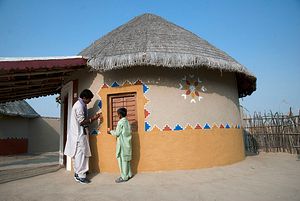Bhungas – a unique type of circular mud hut – are closely linked to the identity of Kutch desert areas of Gujarat. After an 1819 earthquake that caused severe damage to the lives and properties, the people of Kutch came up with the circular design of bhungas, which has been in use for nearly 200 years now. Even after the severe earthquake of 2001, it was seen that despite being very close to the epicenter of the earthquake, bhungas stood firm while many other buildings were devastated.
The diameter of a bhunga is approximately 18 feet and has a depth of foundation up to 24 inches. Lightweight thatched roofs; low walls plastered with mud, twigs, and dung; and an independent circular structure without any corners have made these bhungas disaster-resistant. All these features are helpful against the lateral forces of both earthquakes and storms. Moreover, the mud walls of the bhungas are thick and thus the surface is less susceptible to heat. The small openings keep the room cool in the searing Kutch summers and warm in harsh winters. The circular shape does not obstruct the wind and hence reduces pressure on the structure during cyclones, another frequent occurrence in the region.
Bhungas, with their elaborate design and artistic elegance, portray Kutch culture, tradition, and lifestyle, They demonstrate the ecological, social, and aesthetic aspects of the region.
Sugato Mukherjee is a photographer and writer based in Calcutta and his works have appeared in The Globe and Mail, Al Jazeera, National Geographic Traveler, Harper Collins and Yale University Journal. His coffee table book on Ladakh has been published from Delhi in 2013. Some of his visuals and stories can be found at sugatomukherjee.zenfolio.com













































